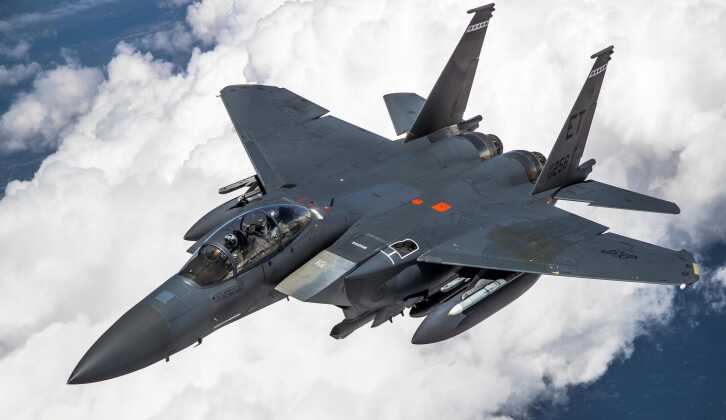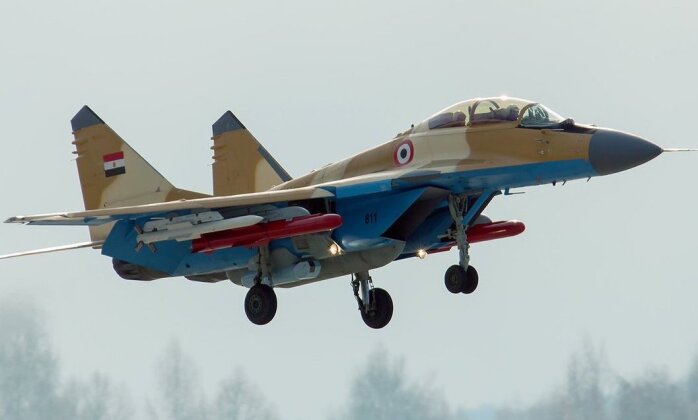Why Israel is Pressing Washington to Sell F-15s to Egypt: Eliminating Cairo’s Military Options

F-15EX Eagle USAF/Ethan Wagner
Following reports on March 15 that a contract for the sale of American F-15 fighter jets to Egypt was under consideration, it emerged nine days later that Egypt’s neighbour and longstanding military rival Israel had not only given its approval to but was actively urging Washington to approve a deal.
Following reports on March 15 that a contract for the sale of American F-15 fighter jets to Egypt was under consideration, it emerged nine days later that Egypt’s neighbour and longstanding military rival Israel had not only given its approval to but was actively urging Washington to approve a deal.
While Egypt has since the 1980s deployed the F-15’s cheaper lightweight counterpart the F-16, it has been denied permission to acquire the more advanced heavyweight aircraft for over four decades while Israel has since the late 1970s operated the F-15 as its primary air superiority fighter.
Although Israel initially opposed F-15 sales to Egypt, which helped to ensure a military advantage, an Egyptian F-15 acquisition will likely take considerable pressure off Israel’s eastern borders and ensure a balance of power in the region more favourable to Israeli interests.
The cause of this is twofold. The first is that versions of American fighter aircraft built for Egyptian use, much like those built for the Iraqi Air Force, are very heavily downgraded providing a negligible capability to seriously threaten those used by Western or Israeli units. Perhaps the most notable example is Egyptian F-16s do not carry any viable standoff air to air missiles, and are rarely seen equipped with any thing other than defensive visual range missiles. The most capable missile made available is the AIM-7 Sparrow, which relies on semi active radar guidance and was considered obsolete by the mid-1990s.
The cause of this is twofold. The first is that versions of American fighter aircraft built for Egyptian use, much like those built for the Iraqi Air Force, are very heavily downgraded providing a negligible capability to seriously threaten those used by Western or Israeli units. Perhaps the most notable example is Egyptian F-16s do not carry any viable standoff air to air missiles, and are rarely seen equipped with any thing other than defensive visual range missiles. The most capable missile made available is the AIM-7 Sparrow, which relies on semi active radar guidance and was considered obsolete by the mid-1990s.
This combined with downgrades, and close American control on how and where Egyptian F-16s fly, ensure that they pose no challenge to the Israeli Air Force in the event of conflict.


Egyptian Air Force F-16s with Short Range Missiles
The second reason for Israeli support for an F-15 sale is that the Egyptian Air Force has since 2013 sought to look away from a reliance on Western armaments, and in 2015 signed a $2 billion contract for 46 MiG-29M medium weight fighters.
The second reason for Israeli support for an F-15 sale is that the Egyptian Air Force has since 2013 sought to look away from a reliance on Western armaments, and in 2015 signed a $2 billion contract for 46 MiG-29M medium weight fighters.
It remains no exaggeration to say that these MiGs are significantly more potent in air to air combat or in standoff air to ground or anti shipping missions than all 200 or so heavily downgraded and underarmed F-16s, and are the only fighters in the Egyptian inventory which can seriously challenge Israeli air power.
The MiG-29M deal was followed in 2018 by another $2 billion contract for an estimated 24-26 Su-35 heavyweight fighters, which are not only more sophisticated but also much heavier and represent the most capable fighters Russia has ever exported. Like the MiG-29M, Russia does not downgrade hardware meant for Egypt treating it as equal to its other defence clients, and does not impose strict controls on how its fighters can be used. The result is that an Egyptian Su-35 acquisition would place significant further pressure on Israel’s western borders which until the late 2010s were for decades considered almost totally secure from the air, and while relations between Cairo and Tel Aviv remain relatively positive the latter consistently plans contingencies for potential changes.


Egyptian MiG-29M with R-77-1 and Kh-35 Missiles
Where the MiG-29M deploys the R-77-1 active radar guided missile with a 110km range for air to air engagements, on par with if not surpassing the AIM-120C used by most frontline Israeli units, the Su-35 can deploy the K-77M and R-37M with 200km and 400km ranges. Combined with the fighter’s reduced radar cross section, triple radars, advanced electronic warfare capabilities, and powerful sensors, the aircraft could pose a formidable threat if equipping elite Egyptian units.
Where the MiG-29M deploys the R-77-1 active radar guided missile with a 110km range for air to air engagements, on par with if not surpassing the AIM-120C used by most frontline Israeli units, the Su-35 can deploy the K-77M and R-37M with 200km and 400km ranges. Combined with the fighter’s reduced radar cross section, triple radars, advanced electronic warfare capabilities, and powerful sensors, the aircraft could pose a formidable threat if equipping elite Egyptian units.
Israel has notably encountered Su-35s in the past, with Russian Air Force fighters escorting Israeli F-16s out of Syrian airspace to prevent attacks on the country. The F-15 by contrast would ensure an Israeli advantage, with not only heavily downgraded avionics but also extensive American control over its operations to ensure it is never used in a way that is contrary to Western interests.
Even if F-15s sold to Egypt are equipped with downgraded variants of the AIM-120C, these will be unable to compete with Israel’s growing numbers of AIM-120D missiles or the upcoming AIM-260 which Israel is expected to be one of the first clients for - with Washington’s propensity to deny these to Egypt ensuring an overwhelming Israeli advantage is perpetuated.
Even if F-15s sold to Egypt are equipped with downgraded variants of the AIM-120C, these will be unable to compete with Israel’s growing numbers of AIM-120D missiles or the upcoming AIM-260 which Israel is expected to be one of the first clients for - with Washington’s propensity to deny these to Egypt ensuring an overwhelming Israeli advantage is perpetuated.
Israeli intelligence sharing with the U.S. will also ensure that the right electronic warfare measures needed to nullify the F-15 or its missiles will be well known to the Israeli Air Force well ahead of any possible clash.
No similar relationships exist with non Western arms suppliers such as Russia. Thus an F-15 sale to Egypt remains highly favourable, not only because it will deny funds to the Russian defence sector and finance that of the U.S., but also for Israeli interests by ensuring that the Egyptian Air Force remains tightly under Western control and incapable of challenging its neighbours in the air.
Cairos’ decision over the F-15, Su-35, and more broadly the future of its fighter fleet at a time of tremendous Western pressure, remains to be seen.
Wakakaka...the true (as opposed to Over-Hyped paper) capabilities of Russian military equipment have , sadly , been heavily exposed in the last 4 weeks of War in Ukraine.
ReplyDeleteThat's if u believed all those orchestrated PS-ed videos & news coming out from yr idol's MSM!
DeleteUkraine is strewn with the carcasses of Russian military equipment ...tanks, armoured vehicles, jets , helicopters....destroyed by Western-supplied missiles....together with the unburied carcasses of their Russian occupants...
DeleteThe Ukrainians have also suffered painful casualties , for sure, but I have Zero sympathy for the dead Russian invaders...the more Russian invaders killed, the higher the price Russia pays for its Barbaric invasion of Ukraine.
Wakakakakaka…
DeleteMfer, saves yr fart, just regurgitate all those western MSM diarrhea, PS-ed & faked inclusive.
Ooop… keep yr sympathy to yrself. U do need it soon!
A very myopic view of weapons and tactics. The longest range missiles only allows for BVR ( beyond visual range) capability. Assuming that the opponent is detected at the furthest point ie AWAC’s capability. It is more about tactics. An Indian MIG21 shot down a Pakistani f-16 equipped with AIM120s. The MIG with a 10km locking range used better tactics , with ground based radar operators, to fire the initial shot. The professionalism of your military plays a big role in the outcome of battles…
ReplyDelete